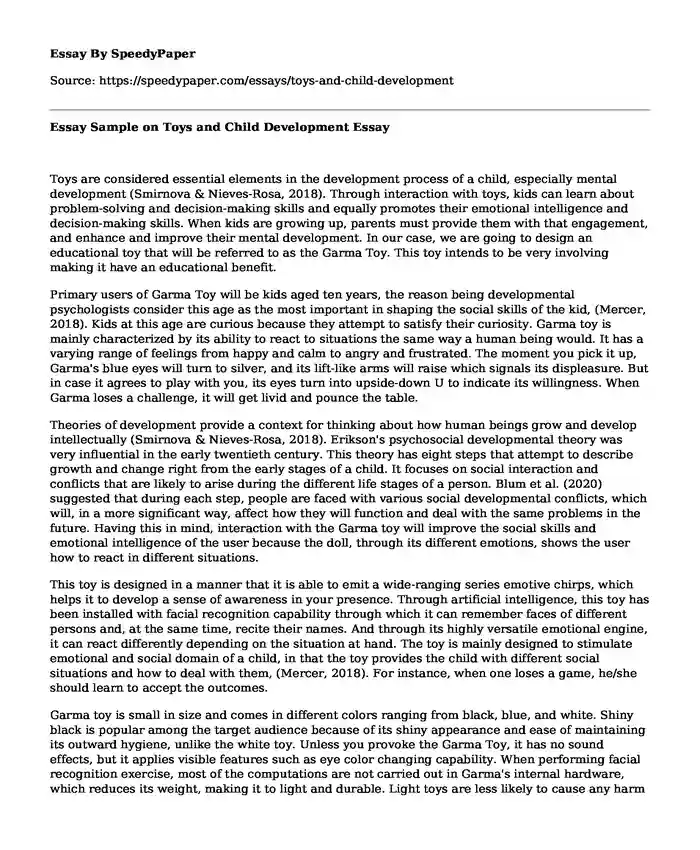
| Type of paper: | Essay |
| Categories: | Games Intelligence Child development |
| Pages: | 3 |
| Wordcount: | 796 words |
Toys are considered essential elements in the development process of a child, especially mental development (Smirnova & Nieves-Rosa, 2018). Through interaction with toys, kids can learn about problem-solving and decision-making skills and equally promotes their emotional intelligence and decision-making skills. When kids are growing up, parents must provide them with that engagement, and enhance and improve their mental development. In our case, we are going to design an educational toy that will be referred to as the Garma Toy. This toy intends to be very involving making it have an educational benefit.
Primary users of Garma Toy will be kids aged ten years, the reason being developmental psychologists consider this age as the most important in shaping the social skills of the kid, (Mercer, 2018). Kids at this age are curious because they attempt to satisfy their curiosity. Garma toy is mainly characterized by its ability to react to situations the same way a human being would. It has a varying range of feelings from happy and calm to angry and frustrated. The moment you pick it up, Garma's blue eyes will turn to silver, and its lift-like arms will raise which signals its displeasure. But in case it agrees to play with you, its eyes turn into upside-down U to indicate its willingness. When Garma loses a challenge, it will get livid and pounce the table.
Theories of development provide a context for thinking about how human beings grow and develop intellectually (Smirnova & Nieves-Rosa, 2018). Erikson's psychosocial developmental theory was very influential in the early twentieth century. This theory has eight steps that attempt to describe growth and change right from the early stages of a child. It focuses on social interaction and conflicts that are likely to arise during the different life stages of a person. Blum et al. (2020) suggested that during each step, people are faced with various social developmental conflicts, which will, in a more significant way, affect how they will function and deal with the same problems in the future. Having this in mind, interaction with the Garma toy will improve the social skills and emotional intelligence of the user because the doll, through its different emotions, shows the user how to react in different situations.
This toy is designed in a manner that it is able to emit a wide-ranging series emotive chirps, which helps it to develop a sense of awareness in your presence. Through artificial intelligence, this toy has been installed with facial recognition capability through which it can remember faces of different persons and, at the same time, recite their names. And through its highly versatile emotional engine, it can react differently depending on the situation at hand. The toy is mainly designed to stimulate emotional and social domain of a child, in that the toy provides the child with different social situations and how to deal with them, (Mercer, 2018). For instance, when one loses a game, he/she should learn to accept the outcomes.
Garma toy is small in size and comes in different colors ranging from black, blue, and white. Shiny black is popular among the target audience because of its shiny appearance and ease of maintaining its outward hygiene, unlike the white toy. Unless you provoke the Garma Toy, it has no sound effects, but it applies visible features such as eye color changing capability. When performing facial recognition exercise, most of the computations are not carried out in Garma's internal hardware, which reduces its weight, making it to light and durable. Light toys are less likely to cause any harm to the kid.
References
Smirnova, E., & Nieves-Rosa, A. (2018). Technological modern toys in early child development. In Vygotsky's Theory in Early Childhood Education and Research (pp. 157-165). Routledge. Retrieved from; https://scholar.google.com/scholar?hl=en&as_sdt=0%2C5&as_ylo=2016&q=toys+and+child+development&oq=toys+and+#d=gs_cit&u=%2Fscholar%3Fq%3Dinfo%3AxzjhJWJj7QJ%3Ascholar.google.com%2F%26output%3Dcite%26scirp%3D9%26hl%3
DenBlum, H., Coates, S., Olesker, W., Parens, H., Ross, J. M., Schechter, D., & Smolen, A. G. (2020). Growing Up: Revisiting Child Development Theories and Their Application to Patients of All Ages. Lexington Books. Retrieved from; https://scholar.google.com/scholar?hl=en&as_sdt=0%2C5&as_ylo=2016&q=child+development+theories&oq=child+dev#d=gs_cit&u=%2Fscholar%3Fq%3Dinfo%3AEikJrBC4AbIJ%3Ascholar.google.com%2F%26output%3Dcite%26scirp%3D1%26hl%3
DenMercer, J. A. (2018). Child development: concepts and theories. SAGE. Retrieved from; https://scholar.google.com/scholar?hl=en&as_sdt=0%2C5&as_ylo=2016&q=child+development+theories&oq=child+dev#d=gs_cit&u=%2Fscholar%3Fq%3Dinfo%3APAlnE588pm8J%3Ascholar.google.com%2F%26output%3Dcite%26scirp%3D5%26hl%3Den
Cite this page
Essay Sample on Toys and Child Development. (2023, Apr 13). Retrieved from https://speedypaper.com/essays/toys-and-child-development
Request Removal
If you are the original author of this essay and no longer wish to have it published on the SpeedyPaper website, please click below to request its removal:
- Management Essay Example: Succession Planning in Nursing
- Admission Essay Example: Why I Chose Medicine
- Essay Example on Braaksma's Lessons Learned From the Assembly Line
- Essay Sample on Napoleon Bonaparte and the Humanities
- Essay Sample: External Forces in Play of Our Identities
- 5 Effective Green Marketing Strategies: Essay Sample
- Paper Example on Assessing Data Quality
Popular categories




